Latest Contributions
Gurgaon Memoirs
Category:
Tags:

Salil Dutt, born 11th August 1949, lives in Jaipur with his wife Suman. Their son Ashish is a financial analyst and their daughter Anuradha, a Clinical Psychologist. Salil's father, Wing Commander Mayukha Kanti Dutt (1915-1998) was born at Sreepur, Kharandip, Chittagong. Salil's mother, Biva Dutt (1924-2003) was born and brought up in Rangoon. She too hailed from Sadarghat, Chittagong. Salil has four siblings. He graduated from St John's College Agra, and retired in 2009 as Vice President, Tata's Indian Hotels Co. Ltd. His interests are sports\; music, particularly Jazz, Classical and fusion\; reading, writing on travel &\; hospitality. He is a food buff.
Sitting under the winter morning sun in our terrace at Jaipur, overlooking the not too distant low-lying hills of the Aravalli range, I indulge myself in one of the most de-stressing activities that I had not done in a long time - shelling green peas. It is quite meditative, and I dare add, therapeutic. It effortlessly empties the accumulated clutter in the mind. During my childhood in Gurgaon in the 1950's and "Dilli" later, it was a favourite winter afternoon activity. Green peas were one of my favourite vegetables, tasty to the core. It made for some of the most popular Indian dishes anywhere - aloo mutter (peas and small potatoes), gobi mutter (cauliflower and green peas), and paneer mutter (cottage cheese cubes and peas), to name a few..
Ma would call the children of our neighbouring family to join us in a circle, each with a small heap of this sweetish vegetable, tossing the shelled skins on to a newspaper placed in the centre. Each of us had a small bowl to fill. The green peas were, of course, harvested fresh by the gardener that morning.
There was a rather large vegetable garden behind our bungalow house, remnant of the Signal's Officer of the Royal Indian Air Force in the early 1940's. There were other seasonal vegetables grown in the garden too, like carrots, cabbage, cauliflowers, coriander, white radish (mooli) and spinach. There were also fruit trees like guava, lime and pomegranate. As children, we would be excited as to who would shell his lot of peas first. The prize would be a Parry's Lacto Bonbon toffee, or perhaps a fruity lozenge. On rare occasions it would be soft &\; colourful fruit jelly candies. They were available in the Air Force Base Canteen. Ma would store them in round toffee cans on the highest kitchen shelf. Of course, the other children would get one each. Competition was healthy, and at the end, there was happiness all around. Life was simple in its lessons in joy and togetherness.

With our next door friends at Gurgaon (1952)
L to R - Dada (Swapan), Girju Lal, Salil (me), Didi (Chhanda), Deepak Lal
February has been colder this year (2019) than in the recent past. The South westerly winds which picked up in December 2018, increased in speed over the next two months. The marriage season was in full swing. Almost every date had been marked on the calendar. Jaipurites wait patiently through hot summers and a reasonable monsoon for some relief. Winter ushers in a pickup in commercial activities, good weather and gaiety. The onset of winter brings in many smiles. With its pleasant weather, winter also brings in the many festivals of art &\; culture. Indeed, it is the tourist season - of sunny afternoons, lazy lunches and celebrations.
The memories of childhood and shelling green peas brought in its share of nostalgia. I shelled peas in relative peace of mind, a decade post-retirement, enjoying the nourishing sun in a reasonably salubrious part of the city. The nostalgic feeling is heightened by the thumris of the season of falgun - Hori, Kajri and Dadra - moods in musical form sung by celebrated classical singers, heralding the onset of the festival of Colours - Holi.
Early memories of Gurgaon 1951 - 1954
My mind goes back to early memories of the Gurgaon I have. It was nearing sunset. We were travelling in a bus, my head swaying drowsily on my mother's lap. The seats in the bus were long on one side, and hard. It sat about 3 persons. I could see 2 or 3 horizontal bars in the bus window, next to our row of seats. I was to understand later that we were travelling from Kanpur, my birth place, to Gurgaon. My father, a Flight Lieutenant, had received his transfer orders to the Indian Air Force Station in Gurgaon, as the Signals Officer. He was about 35 years then. Later, I would see his name painted in white letters on the wooden board outside our gate. It read - "Flt Lt M K Dutt, IAF".

My parents. Flt Lt MK Dutt &\; Biva Dutt. Gurgaon. (1952)
Mayukha Kanti Dutt, my father, hailed from a prosperous Kayastha family in the Chittagong District of undivided Bengal. His father, my grandfather, Bepin Behari Dutt, was a Government veterinary doctor in undivided Bengal. My father had eight other siblings, as was the size of many large families those days, just as it was in my mother's family with the same number of siblings. Mayukha Kanti studied at the Rajshahi College\; completed a course in Wireless Engineering from Calcutta's George Telegraph, and thereafter joined the Royal Indian Air Force (RIAF).
Around 1935, he bid a tearful farewell to all his dear ones at home in Sreepur Village, Kharandwip, Chittagong. It was a sad moment for the entire family, as he was the first born. After his initiation in the Royal Indian Air Force, he soon took part in WW II. He was commissioned in 1950 as a Pilot Officer in the Tech Signals branch of the Indian Air Force. His Parchment Commission was signed by India's Supreme Commander of the Defence Forces, India's first President, Dr Rajendra Prasad.
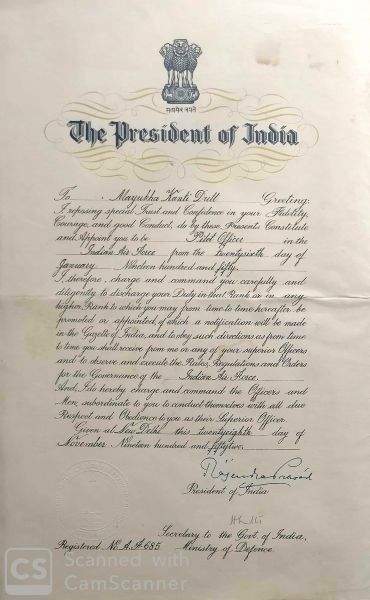
Parchment Commission of MK Dutt, signed by His Excellency Dr Rajendra Prasad, First President of India
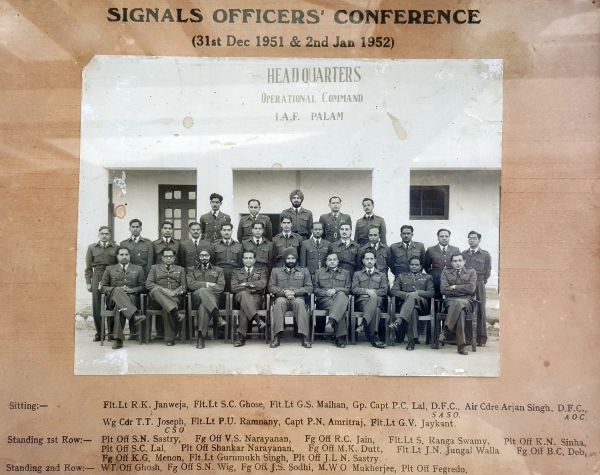
IAF Signals Officers' Conference, Palam 1952
Gurgaon impressions
My first impression of Gurgaon was of endless swathes of fields, vast farmlands, brown and dry. There were scattered thorny shrubs and trees - babool, khejdee &\; neem. There was one straight road in the station - on one end was the power house and at the other end was the main entrance guard room. With its street lights, this road looked like a small air strip from the sky. Indeed, mistaking the road for a runway one evening after sunset, an aircraft made a couple of low passes with the intention of landing and Baba got very worried. He rushed to the phone and passed instructions to the Power House - the street lights were switched off, forestalling the pilot from his error and a possible accident was thus averted.
The road outside the guard room appeared to lead to the big world outside. I had no idea then how big this world was. This road would connect to the Gurgaon road, now known as the Old Delhi - Gurgaon road. On the right of our bungalow, i.e., behind the rear garden, there were quarters for other MES (Military Engineering Service) staff. Some of the families were displaced after partition. I had no idea of the trauma they went through to decide where they were going to live. This was similar to the situation in the Eastern part of India. The partition of Hindustan left hundreds of thousand people, broken in mind, spirit and means to living. The nationalistic spirit in the wake of the partition, created a wave of spontaneous inclusion across the citizens of India.
The bungalow we lived in
I recollect the bungalow that was allotted to my father. The design was simple and functional. During the Raj, British designers, PWD engineers and architects, played an important role in setting the foundation to buildings in India. It was a small lime washed bungalow with shuttered green windows, country cousins of the Lutyens' Delhi houses. At the entrance was a rectangular verandah of about 10 feet by 15 feet, flanked by two lime washed pillars, one on each side. The white shade had a tint of Indigo blue, added those days to soften the whiteness. The floor was of square grey Kota slabs. The facing wall had two doors, the left led into the bed room, and beyond that to the dining room. The right door led to the drawing room with polished grey cement floor. The guest toilet was in the right side of the verandah.
On the left side and adjacent to the bedroom was a small room, where my younger brother Rajat (Raju), now a retired tea planter and consultant, was born in January 1953. There was only a nurse and a midwife present during his birth. Spaces appeared big then, as did the high ceiling. The floor in the rest of the house was of grey stone slabs. This was to be our residence till end of 1954, after which my father was posted to the Air HQ, New Delhi.
The smartly trimmed hedge surrounding the front of the bungalow overlooked a large football field. This field was used each morning for parade by airmen under the command of my father. In the evening it was used for PT drill and games. Baba was an excellent parade commander. From an early age, he taught my brother and me the commands necessary to conduct a parade, and this helped inculcate leadership qualities in us.
The bungalow looked homely with freshly lime washed exterior paint. Ma had grown creepers up the walls in front, with orange (Bignonia venesta) and light blue (Ipomoea) flowers. There were also some jasmine (chameli) flower bushes, and Raat ki rani, whose fragrance filled the evening air.

Gurgaon 1952, in front of the bungalow we lived in (L to R - Dada, Ma, Didi, Baba &\; me)

Gurgaon 1952 (Dada, Didi &\; me)
The Power house and barracks:
Across the field was a group of single floor structures that housed the offices, mess, Canteen stores, airmen billets, etc. Behind these was the Power house with a small stone fountain on a circular patch of grass. The flower beds and lawns used to be marked with white washed bricks laid at an angle. They made the surrounding look smart. We often went for walks there with an orderly named Hem Singh. Sometimes we were pampered with glasses of cool rose flavoured 'sharbat' - Rooh Gulab. We received a lot of attention from the staff. That was the world my mind traces till today.
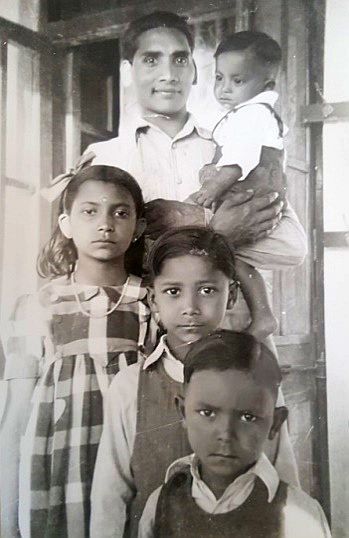
Hem Singh with Raju in his arms\; Didi, Dada &\; me
(In the front verandah of the Gurgaon bungalow - 1953)
Mother (Biva)
Ma was called "Memsaab". She gave all instructions for house cleaning and cooking to the khansama (bearer) and bawarchi (cook). The bathrooms were cleaned by a "jamadar", while two faithful "laskars", Hazarilal and Biharilal, tended to all the garden work and odd jobs. They were a big help to Ma. I remember them only in khaki uniforms &\; Gandhi topis.
Ma was everything rolled into one super pack. She taught us how to make kites from colour tracing sheets and fly them during windy baisakhi weather under heavy clouds. She fed us, applied oil on our heads before bath. She bathed and clothed the youngest. She knew everything and had all the nuskas (solutions) required to run the family smoothly. Indeed, she was the world to us. All this lasted till we were old enough to do these tasks ourselves.
Ma was adept in five languages: Hindi, Tamil, Bengali, Punjabi and Burmese. The last, because her father Rebati Raman Ghosh, worked as a Block Development Officer in Rangoon, where she and her eight siblings were born and educated. The Ghosh family moved to India after Burma fell in the hands of the Japanese. All vegetables needed for our meals were grown in the rear vegetable garden. If anything was not there, then our neighbour, well-wisher and trouble shooter, came in the form of the grand and venerable "Uncle" Saheb Ram Ahuja.
Sahib Ram Ahuja
He was Baba's closest well-wisher. His family comprising wife, daughters Urmila and Sudesh and son Ved Prakash, were closely linked to our family in every occasion. There were three other children, but I was too young to remember. The Ahuja family lived in the MES quarters adjoining our bungalow. Sahib Ram ji played an invaluable support role to our family during our stay in Gurgaon. During the festivals like Diwali, he would bring homemade sweets, in particular jalebis, the size of tea saucers! On Basant Panchami day, everybody wore clothes dyed yellow. The colour was made from dried palash (kesu) flowers. On that festival day in 1952, we siblings planted fruits trees: my eldest sister Chhanda (Didi)D - a Pomegranate (anar) tree, elder brother Swapan (Dada) - a Guava (amrud) tree, and me - a lime tree (nimbu).
Sahib Ram ji was always impeccably dressed in traditional white salwaar kameez suit, usually with a black coat in winter. On special occasions, he wore a braided waist coat, black shoes and a turban with a hard material golden top, called kula - typical of a Pathan's attire. He looked dignified with his long moustache curving at the ends, kind eyes and a benign smile. He exuded an aura of generosity, kindness and deep understanding. With him there, all problems seemed to vanish, even when he himself may have had to suffer unspoken hardships. Today I look back on my hazy memory of this man. Whenever he came home, being the youngest of the three siblings, I was always the last to greet him, after Didi and Dada.
The ladies of the Ahuja family used to help Ma in many ways. When Raju, my younger brother, was born during January 1953 in Gurgaon, just before lohri, Sahib Ram ji and his family made the day memorable by placing baskets of patasa, revari and fruits all around his crib. When Ma fed Raju milk from a bowl while cradled in her lap, she would sing a village rhyme to coax him to drink the milk. It went something like this:
Ummad ghummad doodh biloey, jaathni ka chhora roey,
Ronna hai to rone de, Ma ko doodh biloney de.
Perhaps she learnt this song from the Ahuja ladies, or perhaps she picked it up when Baba was posted in Amritsar. We would sit and watch this with amusement. There was so much joy in that feeding chore.
The Ahuja family of Bannu
Many years later, in more recent times, Ved Prakash ji, Sahib Ram Ahuja's second son, explained more of his family history in erstwhile North West Frontier Province (NWFP). This is important to understand how undivided Hindustan (India) was during the early half of the 20th century, i.e., specifically from 1930 till 1945. The Ahuja family were orthodox and came from NWFP, now known as Khyber Pakhtunkhwa and the other tribal areas of Waziristan. Sahib Ram ji hailed from the area called Bannu, a sub-principality (tehsil). There were other such principalities from where many non-Muslims migrated to post independence India, like Kohat, Dera Ismail Khan and Peshawar, etc.
During the late 1930's, or around the time WW II started, Sahib Ram ji was in the Frontier Scouts. There were different scout groups. Such tribal groups were conversant with their local areas, intricate ravines and passes and the maze of the hilly areas. They were indispensable to the Army and the RIAF. The RIAF had set up their first air bases in Miran Shah, Karachi and few other areas. Sahib Ram worked for the RIAF as a frontier scout.
Ved's mother, named Bhraava (pronounced with a slight nasal accent), was from the bordering province of Ghazni, in East Afghanistan. She had blue eyes and good features, like other ladies from her area. I vaguely remember her as someone who was mostly hidden behind the others. I cannot remember the faces of the ladies. The tribals from Pashtun were highly orthodox, and did not allow their ladies to come in front of guests. It was their custom. Ghazni had other proximate towns like Posht and Tochi. The tribals across the border mixed freely. NWFP had extreme weather conditions, and hence people were very hardy.
When India was partitioned, like thousands of others who had to decide, it was a very difficult decision for Sahib Ram ji. He could not reconcile to being uprooted from his own village (pind). He was most reluctant to leave. After much persuasion from relatives and community members, he agreed to move to the heartland in India. His heart wrenched on having to leave Bannu. In 1947, Ved Prakash, 6 years then, had an elder brother and three younger sisters. Like Sahib Ram Ahuja, thousands of such Punjabi families were forced to relocate themselves, spread across Punjab, including the state now called Haryana\; to Delhi, Rajasthan, Himachal Pradesh and U.P. Their progeny today, are second or third generation urbanites, who have intermingled and adapted themselves into the local ways of living, assimilating their customs and traditions with their own.
Saanjha Choola
When Saheb Ram ji came home, there was happiness all around. My parents held him in high regard. After sunset, his two daughters, Sudesh and Urmilla, joined other ladies from the hamlet to bake rotis in a handmade underground hearth called bhatti. This kind of traditional community baking in one hearth, was called Saanjha choola. The rotis, smeared with homemade butter (ghee) from cow's milk, and eaten rolled with crushed jaggery (bhoora), tasted delicious in winter. The vegetables were truly of the earth, unadulterated and 100% organic, without any pesticides. The day's work started early around 7 am and ended by lunch time. Thereafter it was rest time for all categories of staff and workers. There was enough time to play, study and have meals, which was always a complete family ritual. Next, rest was an important part of the afternoon. During the hot summer days, Ma used to cut seasonal fruits and apportion them to us, as we sat in front of khaskhas (dry long vetiver) coolers. The evening was play time with the other children. Fun, like the fresh grown vegetables, was unadulterated.
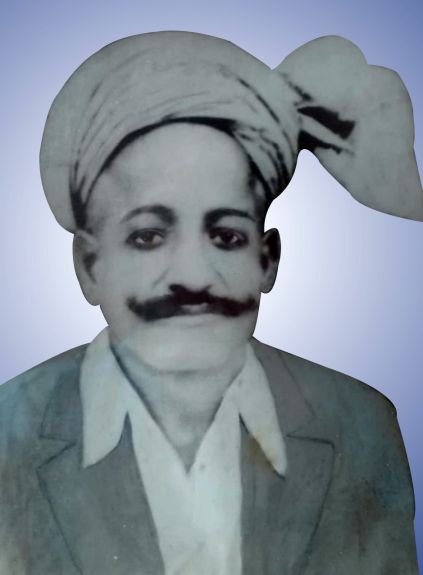
Sahib Ram Ahuja (Gurgaon - 1953)

With Ved Prakash Ahuja (at Jaipur - 2019)
Study time and story time
Since there were no schools close by in Gurgaon at that time, we received tuition at home from "Master- Moshaay" (teacher), a Bengali gentleman from whom we learnt the rudiments of Bengali, English and Arithmetic. He did spare the rod, allowing us liberal breaks to drink water.
Another older gentleman, father of one Master Warrant Officer Bhattacharyya, was a genial Dadu (grandfather). During the summer heat, we would spot him from far, walking across the field in the sweltering summer loo heat. He would then sit in the cool khas-khas room and recite children's rhyme in Bengali and Hindi. One such dramatic rhyme was - "Raja ki seengh, Raja ki seengh, kinnay kaha, kinnay kaha - Babbu hajjaam ne, Babbu hajjam ne..". We rolled in gleeful laughter watching his expressions, particularly, when he emphasised on the word "BAB-BU", like a tabla beat. There were endless other stories and folklores, which we never got tired of listening. Ma would make cool lime juice sherbet or raw mango panna. Entertainment came in simple packages, like this Dadu. Studies at home kept us busy at mid-day and out of Ma's hair.
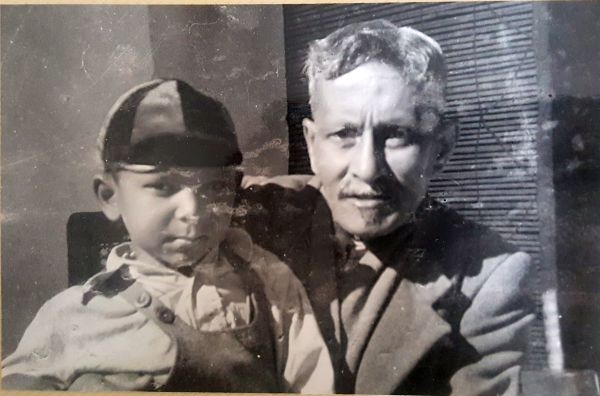
"Gurgaon Dadu" with me (1951)
Family outing in horse carriage (Tonga)
On days when the family went shopping to Gurgaon, it would be in a village horse carriage called Tonga. The Tonga had a seat in the front for the driver, and a rear seat for 2 to 3 passengers. Due to the weight distribution of the passengers, it tended to tilt on the rear side. This was managed by the owner driver. Baba and Ma sat behind with one of us in lap. The elder siblings sat in front with the driver for safety. The horse used to swish his tail to ward off flies, which amused us. This was the only form of light transportation. For a trip to Delhi, Baba used to avail of a 'liberty run'. A liberty run was in a 3-ton military vehicle. This vehicle would take other families too, operating as a free shuttle on specific days of the week.
Maya and Mriga
The location of the Wireless Unit was in an endless field, where deer herds roamed freely, as did Nilgai (blue bulls), and wild dogs. The laskars used to talk of rare sightings of panthers and leopards, but far from human habitation. One day, a local village boy brought a small fawn in his arms, and gave her to Ma. He said that while grazing his cows in the fields, they had spooked a herd of deer close by, leaving behind this helpless fawn. Ma's heart melted with motherly emotion. She held the fawn close and gave her comfort. After that the fawn never left her side. She named her Maya, and fed her milk from a crescent shaped double nippled milk bottle, which I had used as an infant. A year later, the gardeners brought a young buck home to give company to Maya. Ma named him Mriga. They pranced in the back garden and ran all over the fenced compound, safe inside. We ran after them with innocent joy.

Ma &\; Maya (Gurgaon - 1954)
Maya was very loving because she came to us in an infant stage. Mriga was a little older. He was less friendly and often chased us, butting us lightly with his head bent down. His horns were growing. I remember when Baba used to conduct parade in the morning, Maya would prance around him, while he was marching. This used to embarrass Baba. When Mriga's horns grew longer, he started getting aggressive by natural instinct. So father had the laskars relocate them in a shelter for deer, in the Senior Officers enclave in Delhi. We watched them being taken away with tearful eyes. Maya and Mriga became an indelible part of my Gurgaon memory.
Return in 1985-86
I never went back to the Gurgaon of my childhood. Didi and I did try once in the mid 1980's. In hind sight I felt that we should not have .... my happy memories of 1951-54 would have remained as pristine as it had always been.
Since it was getting closer to dusk, it took time &\; many enquiries between Vasant Kunj &\; Gurgaon, to locate the bungalow after over 30 years. There was neither GPS nor any mobile phones and we had to depend on our hazy memory. Didi's husband, Air Commodore S C Dutta, my Jija ji, had phoned up the CO at Air Force Station Gurgaon to receive us and facilitate our mission. After driving past the Maruti depot, we finally located the familiar road turn to the Air Force station. The Air Force station had become larger. But darkness was fast enveloping the surroundings. We had to return to Delhi.
The Commanding Officer took us to our old home. The bungalow was almost dilapidated. The gate appeared rusty and no officers lived there. The ceiling appeared low, and the floor tiles had become rough with time. A family lived there. They were kind enough to allow us inside. My heart broke as a flood of memories rushed back. Words between Didi and me became hushed and hoarse, choking with emotions, as we moved with familiar steps from room to room. The family followed and looked at us with curiosity. In the near dark, we went to the kitchen garden. It did not seem so large any more. It was a ghost of a patch, untended and unkempt. "Were there any fruit trees, we asked, ... a lime, pomegranate, or perhaps a guava tree?" Blank faces looked at us. We bid farewell and thanked the family. On the way back, there was no conversation between us. There was only silence and hidden tears.
The lyrics of a song from the film "Umrao Jaan" by Muzzaffar Ali echoed through the silhouette of passing trees:
Yeh kyaa jagah hai doston, Yeh kaun saa dayaar hai, Had-é-nigah tak jahaa,
What place is this friends, what kind of region is this, where, for as far as the eye can see
Gubar hi gubar hai, gubar hi gubar hai, yeh kaun jagah hai doston
There is only endless space and endless space, what place is this friends
Gurgaon Sector 33 (2019)
The old Delhi - Gurgaon road, that long road leading to the Gurgaon Air Force Station, has since been broadened and further extended under the Haryana Government. It has become a major connect to the Jaipur Delhi NH - 8, turning in at the IFFCO Chowk. The old Delhi - Gurgaon (now Gurugram) road runs alongside NH 8, having the Trident hotel at the turn from NH8, the Hyatt Place, Columbia Asia Hospital, Ansal Plaza Mall close by, a Food village and many other big brands. The old Delhi - Gurgaon road connects west to Mehrauli and Dwarka. The area falls under Sector 33. Beyond this sector, upper north, is the Indira Gandhi International Airport (Palam).
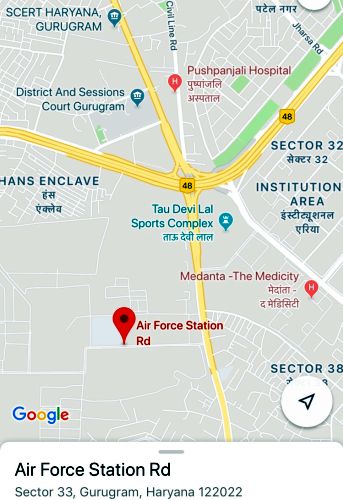
Current (2019) Google map depicting Air Force Station Gurugram
The Maruti Car factory has now been shifted due to space constraints. There are many other Air Force establishments in the close vicinity. The major complexes include tall residential apartments of Unitech\; and their select address called "Unitech - The villas". Around but proximate to Sector 33 are the Laxmi Gardens, Pace City, and Hans Enclave. Many other Real estate brands have multi-storeyed residential apartments, spread out with well-planned public facilities. There are well built roads with commercial centres, public parks, IT hubs, BPO call centres, hotels, Gurgaon Metro Station\; all located in and around the area we once resided.
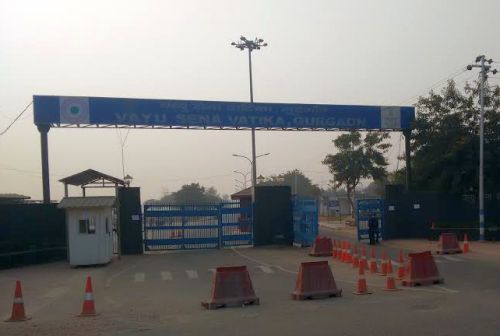
Entry Gate to AF Station Gurugram (2019)
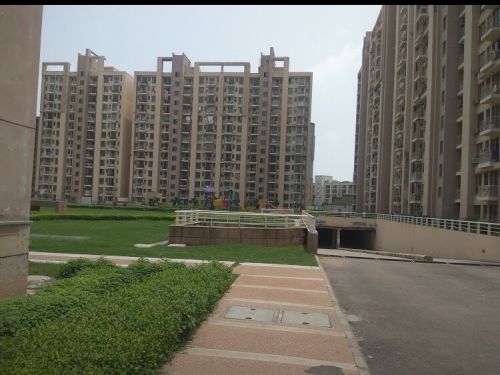
Unitech Residences, Sector 33 Gurugram (2019)
It is difficult to recognise what 70 years can do to remote agriculture areas where we lived in the early 1950s. Life was simple, healthy and happy ... where deer once roamed freely. And now there are buildings similar to those in America and other western countries, along with dual carriage ways with cars buzzing all over.
______________________________________
© Salil Dutt2019
Comments
Add new comment